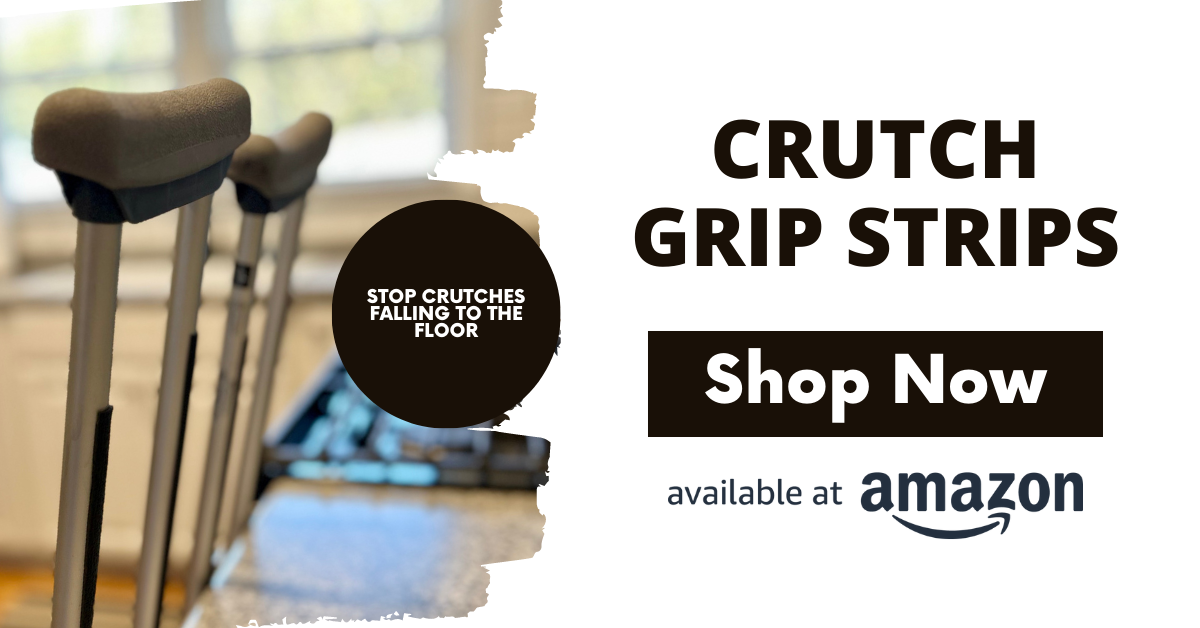Enhancing the Crutch Experience: How Can Crutches be Improved?
Crutches have long been a reliable mobility aid for those recovering from injuries or with mobility limitations.
However, traditional crutches come with their own set of challenges, ranging from stability issues to discomfort and potential slipping hazards.
The good news is that advancements in materials, design, and accessories have opened up avenues for improving the crutch experience.
In this article, we will explore the common problems associated with traditional crutches and discuss various ways to enhance their functionality and user experience.
We will delve into techniques for easier walking, methods to make crutches more comfortable for hands and arms, and even touch upon innovative solutions on the horizon.
Additionally, we will introduce a practical accessory called Crutch Grip Strips, designed to prevent crutches from slipping off edges and giving crutch users peace of mind that when taking a break from using the crutches, the crutches aren’t going to go falling to the floor.
Common Problems with Traditional Crutches
Traditional crutches have long been relied upon for mobility assistance, but they do present certain challenges. Let's address some of the common issues:
Stability: Traditional crutches may require a significant amount of upper body strength and balance, making it challenging for users to maintain stability while walking or navigating uneven surfaces.
Discomfort: The underarm pads of crutches can cause discomfort and pain with prolonged use, leading to soreness in the armpits and upper body.
Slipping Hazards: Slippery surfaces or irregular terrain pose a risk of crutches sliding or slipping, potentially causing accidents and injuries.
Enhancements for Improved Crutch Experience
To address these challenges and enhance the crutch experience, various improvements have been made. Let's explore some key enhancements:
Ergonomic Design: Modern crutches are designed with ergonomics in mind, focusing on user comfort and stability. These crutches often feature adjustable height settings, padded handgrips, and innovative weight distribution mechanisms to reduce strain on the body.
Alternative Materials: Traditional crutches were primarily made of wood or aluminum, but newer materials like carbon fiber and lightweight alloys offer improved strength and durability while reducing overall weight.
Shock-Absorbing Systems: Some advanced crutch models incorporate shock-absorbing technology, which can help reduce impact and vibrations, resulting in a smoother and more comfortable walking experience.
Making Crutches Easier to Use
Here are some techniques and tips on how to make walking with crutches easier and more efficient:
Proper Body Alignment: Stand up straight, align your body with the crutches, and distribute your weight evenly between the crutches and your non-injured foot. Avoid leaning heavily on the crutches to prevent strain.
Taking Smaller Steps: Take small, controlled steps while keeping the crutches close to your body. This helps maintain balance and stability during movement.
Navigating Stairs: When climbing stairs, use the "up with the good, down with the bad" approach. If the injury is on your right side, lead with the left foot and crutches when going up. When going down, place the crutches and injured foot down first, followed by the non-injured foot.
Enhancing Comfort for Hands and Arms
To make the crutch experience more comfortable for your hands and arms, consider the following suggestions:
Padded Handgrips: Upgrade your crutches with handgrips that feature extra padding or gel inserts. These provide cushioning and reduce pressure on the hands.
Proper Hand Placement: Ensure your hands are positioned correctly on the handgrips, allowing for a natural and relaxed grip. Avoid gripping the crutches too tightly, as this can lead to discomfort and fatigue.
Crutch Grip Strips: Introducing Crutch Grip Strips, a practical accessory designed to prevent crutches from slipping off surfaces. These strips are easy to install, providing a secure grip to edges when crutches are not in use, and preventing accidents caused by slipping or shifting.
Addressing Common Problems and Solutions
While traditional crutches have their limitations, there are innovative solutions on the horizon that aim to address these issues:
Hands-Free Crutch Alternatives: Innovations like knee scooters, hands-free crutches, and crutch alternatives offer new options for mobility support, allowing individuals to navigate their environment without relying solely on traditional crutches.
Smart Crutch Technology: With the advent of smart technology, crutches equipped with sensors, Bluetooth connectivity, and data tracking capabilities are being developed. These advancements aim to provide real-time feedback on gait, posture, and weight distribution, allowing for more personalized and efficient rehabilitation.
Innovations and Future Improvements
The world of crutches is evolving, with ongoing research and development focused on enhancing the crutch experience. Some potential future improvements include:
Advanced Grip Materials: The development of advanced grip materials can offer better traction and reduce the risk of slipping.
Integrated Shock Absorption: Further advancements in shock-absorbing systems can provide even more effective impact reduction and enhanced comfort.
User-Centric Design: Designers are focusing on user feedback to create crutches that are not only functional but also aesthetically pleasing, lightweight, and customizable.
Crutches play a vital role in aiding mobility and recovery for individuals with injuries or limitations.
Recognizing the challenges posed by traditional crutches, ongoing efforts to improve their design, materials, and accessories aim to enhance the overall crutch experience.
By incorporating ergonomic designs, alternative materials, and practical accessories like Crutch Grip Strips, we can make crutches safer, and more comfortable, and ultimately provide individuals with greater mobility and confidence during their recovery journey.
Embracing innovative solutions and looking towards future advancements will continue to shape the future of crutches, creating a more user-friendly and inclusive mobility aid.

